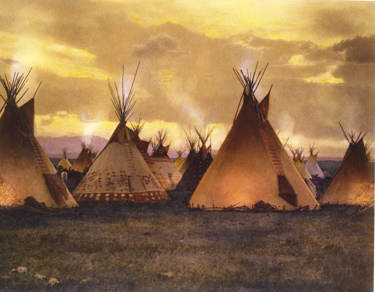Submitted by ARASAllison on
 This beautiful article by Joan Golden-Alexis begins inside the circle of a tipi at the Brooklyn Museum, New York and continues in growing circles to describe the art and life of the Native Americans as the underlying structure of their culture. We experience an extraordinary sense of wholeness in their way of bridging earth and sky – as mundane and sacred, masculine and feminine, the visible world and the invisible. This is part of our series of presentations from The Art and Psyche in the City Conference held at New York University, 2012. By a lucky coincidence, the Metropolitan Museum in New York City has just opened an astonishingly beautiful show called The Plains Indians: Artists of Earth and Sky. - Ami Ronnberg
This beautiful article by Joan Golden-Alexis begins inside the circle of a tipi at the Brooklyn Museum, New York and continues in growing circles to describe the art and life of the Native Americans as the underlying structure of their culture. We experience an extraordinary sense of wholeness in their way of bridging earth and sky – as mundane and sacred, masculine and feminine, the visible world and the invisible. This is part of our series of presentations from The Art and Psyche in the City Conference held at New York University, 2012. By a lucky coincidence, the Metropolitan Museum in New York City has just opened an astonishingly beautiful show called The Plains Indians: Artists of Earth and Sky. - Ami Ronnberg
Western science, following Roger Bacon, believed man could force nature to reveal its secrets; the Sioux simply petitioned nature for friendship.
Vine Deloria, Jr.
This project begins when I stand inside a tipi at the Brooklyn Museum. The tipi’s buffalo skins seem like a translucent glowing parchment revealing huge illuminated spirit animals painted over the entire outside cover. Inside I feel surrounded by and held in the embrace of their protective presence. At the same time that I am aware of the poles that cross these shadow-like silhouettes, reaching out through the smoke hole to the zenith, I am aware that I am standing in a circle. I feel drawn up to the sky, held by the earth and enclosed in something otherworldly and deeply instinctual all at the same time. I feel transported into another realm and begin to understand what Jung meant when he said, that the American Indians live under a spell—the spell of their land, and the spell of their sky. I am drawn to understand both the power of and the inner tranquility that this experience evokes.
Jung describes the white Americans as disconnected from their land and its rich offerings, zooming across its surface with a resultant loss of connection with their own bodily rhythm and their depth. For Jung the white Americans’ disconnection from the land results in dissociation and a split in their psyche.
In contrast, “under the spell of their country” (C.G. Jung, Vol. 10 §960) the American Indian has access to an internal dimension; this allows for fluidity, a connecting and interweaving of the mundane and the sacred, and the conscious and the unconscious. As a result the American Indian resonates with this inaudible cosmic pulse, responsive to both time and place. For him life is not a shallow horizontal stream flowing out of an impatiently forgotten past through the present into a future one is hurrying to reach. Rather, it has a vertical dimension that cups past and future in a timeless present. (Waters, p. 335) This allows entrance into something ancient and primordial—a fluid space, which brings the American Indian’s sacred symbols into consciousness. These symbols then take on a defining reality, penetrating his character, providing him with an essential dignity.
Read The Native American Sense of the Sacred: The Tipi as a Collective Transformational Vessel in its entirety.